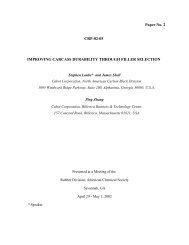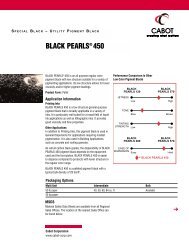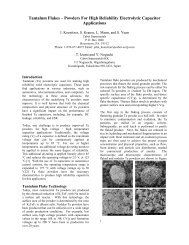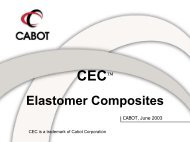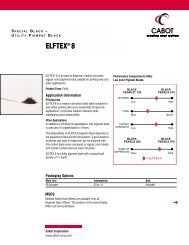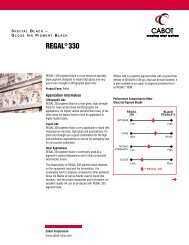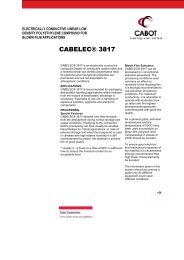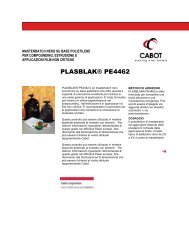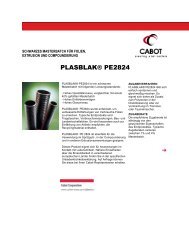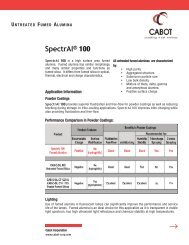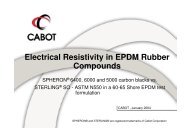Effect of Functionalization of Carbon Black on Rubber Properties
Effect of Functionalization of Carbon Black on Rubber Properties
Effect of Functionalization of Carbon Black on Rubber Properties
You also want an ePaper? Increase the reach of your titles
YUMPU automatically turns print PDFs into web optimized ePapers that Google loves.
0.24<br />
0.21<br />
0.18<br />
0.15<br />
0.12<br />
0.09<br />
0.06<br />
0.03<br />
0.00<br />
measurement, CRX2124 shows a 24% reducti<strong>on</strong> in tan δmax relative to the carb<strong>on</strong> black<br />
c<strong>on</strong>trol and this difference is further increased to 33% by the additi<strong>on</strong> <str<strong>on</strong>g>of</str<strong>on</strong>g> 1.0 phr TESPT.<br />
Both results from strain and temperature sweeps suggest that owing to its lower hysteresis<br />
at high temperature, CRX2124 will give substantially lower rolling resistance in relati<strong>on</strong> to<br />
carb<strong>on</strong> black.<br />
Abrasi<strong>on</strong> resistance<br />
tan δ max<br />
N110<br />
CRX2124 +<br />
TESPT 1.0 phr<br />
As discussed earlier, with regard to abrasi<strong>on</strong> resistance, silica has a significant deficiency in<br />
polymer-filler interacti<strong>on</strong>. In NR, the deficiency cannot be effectively compensated for by<br />
chemical linkages between polymer molecules and the silica surface via the coupling agent<br />
as the reactive groups, i.e., silanols may be blocked by adsorbed n<strong>on</strong>-rubbers. 12 This could<br />
also be applied to the silica domain <strong>on</strong> CSDPF. However, as indicated in Figure 15, the<br />
abrasi<strong>on</strong> index <str<strong>on</strong>g>of</str<strong>on</strong>g> the CRX2124-filled compound measured at 7% slip ratio is <strong>on</strong>ly about<br />
17% lower than its carb<strong>on</strong> black counterpart. The negative impact <str<strong>on</strong>g>of</str<strong>on</strong>g> the silica domain <strong>on</strong><br />
the abrasi<strong>on</strong> resistance seems to be partially <str<strong>on</strong>g>of</str<strong>on</strong>g>fset by the high surface activity <str<strong>on</strong>g>of</str<strong>on</strong>g> carb<strong>on</strong><br />
domain <strong>on</strong> the aggregates. By additi<strong>on</strong> <str<strong>on</strong>g>of</str<strong>on</strong>g> 1.0 phr TESPT, the abrasi<strong>on</strong> resistance <str<strong>on</strong>g>of</str<strong>on</strong>g><br />
CRX2124 can be further improved, making it closer to that <str<strong>on</strong>g>of</str<strong>on</strong>g> carb<strong>on</strong> black N134, <strong>on</strong>e <str<strong>on</strong>g>of</str<strong>on</strong>g><br />
the preferred reinforcing fillers for truck tire tread.<br />
18<br />
NR, Filler: 50 phr<br />
70°C, 10 Hz<br />
CRX2124<br />
Figure 14. Comparis<strong>on</strong> <str<strong>on</strong>g>of</str<strong>on</strong>g> tan δ max <str<strong>on</strong>g>of</str<strong>on</strong>g> NR compounds filled with a variety <str<strong>on</strong>g>of</str<strong>on</strong>g> fillers



